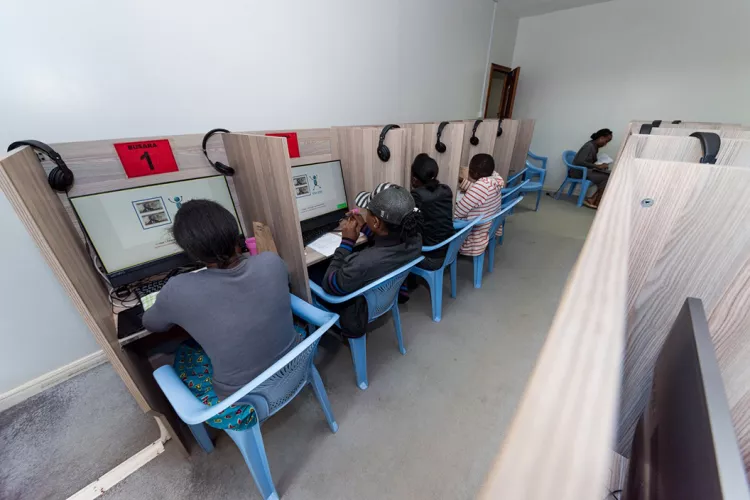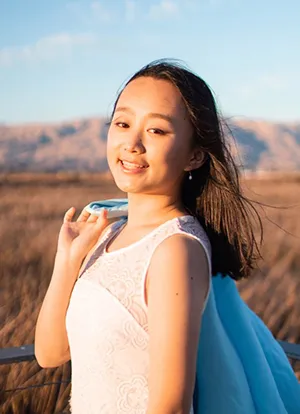Behavioral Economics Students Spend J-Term Designing Experiments with Research Partner in Kenya

In the stationary lab of the Busara Center for Behavioral Economics, in Nairobi, Kenya, participants engage with experiments designed by research partners, including students from Swarthmore.
It’s one thing to read about economics but quite another to apply what you’re learning in real time, in the real world.
So say the students in Behavioral Economics, a course taught this January by Assistant Professor of Economics Syon Bhanot. As part of the course, the students (in groups of four or five) designed behavioral economics experiments that will be implemented with real subjects by the Busara Center for Behavioral Economics, a research partner in Nairobi, Kenya.
“I had done research at Swarthmore, but it was all theoretical,” says Martin Rakowszczyk ’22, an economics and linguistics major from Rockville, Md. “I’ll definitely look back fondly on getting a chance to design experiments that are actually carried out in real life.”
“I think this sort of material, and methods, are hard to learn purely in the abstract,” adds Bhanot. “Especially in the remote environment, I feel it is important to apply the concepts in a concrete way — even if it does require students to think fast.”
Faster than ever, in this case. The course took place in Swarthmore’s January term (J-Term), an optional and online-only term offered for the first time this year to help bridge the gap between the fall and spring semesters that was widened by the global pandemic.
More than 120 students enrolled in the course, which mixed prerecorded and live lectures with guest speakers (including faculty from Harvard University, the University of Chicago, and Stanford University) to foster immersive experience.
“The pace was intense,” says Rakowszczyk, “but it was a really cool experience to go very in depth on a subject every day for several hours, an experience you don’t find in the traditional college setting.”
Fitting a semester’s worth of lessons into four weeks challenged students and faculty alike, says Annie Ping ’24, of San Jose, Calif. “But as a first-year, [the J-Term] gave me a chance to explore classes I otherwise may not have.”
In designing experiments, some students focused on the familiar, from the economics of risky decisions people make in the age of COVID-19 to how best to encourage healthy food choices. Others veered from areas of personal experience to study things like how Nairobi residents process information about crime in the city, or how to encourage the use of energy-efficient cook stoves in Kenya.
“That’s just one example of a significant problem in the developing world,” says Bhanot, “but probably not one most of the students have been exposed to. That was something I liked about this opportunity to partner with Busara; it allowed the students (and me) to grapple with topics outside many of our day-to-day lives."
Rakowszczyk and his team designed an experiment on a mobile betting game, to see whether warning users at the outset about the strong possibility of losing money would discourage them from playing.
“Mobile gaming is a major problem among millennials,” Rakowszczyk says, adding that insights from the experiment could lead to new gaming-platform regulations in Kenya, where online gambling is an issue.

Annie Ping '24
Ping’s group examined whether differences in displayed information could shift a user’s emotions and decision-making. Subjects in their game got an initial payout of $1 and the chance to open a series of 10 boxes. When presented with each box, they could choose to keep the money they already had or press their luck to possibly get more — but only the control group was able to track their earnings.
“We thought this was important to run because different entities — such as firms, governments, and gambling institutions — are able to change the salience of certain information to manipulate customers’ behavior,” says Ping.
Ping and her classmates redesigned their experiment three times to incorporate new ideas they learned in class. They also benefited from constant, iterative feedback from Busara Center staff, the course’s teaching assistants, and Bhanot, shared via the messaging platform Slack.
Bhanot and Swarthmore have a history with the Busara Center. Bhanot met Busara’s founders during his graduate studies and has partnered with them several times to design and run behavioral economics experiments in developing countries. He has also, with the support of the Lang Center for Civic and Social Responsibility, set up a summer internship for Swarthmore students at Busara; the center has hosted two Swarthmoreans every year since 2016.
The Busara Center, which strives to build connections between academic institutions and other groups with similar missions, relished the collaboration with Swarthmore.
“Working with bright minds who in a span of three to four weeks learned the concepts in class and are now able to apply it to designing their own interesting ideas is breathtaking,” says Anisha Singh, the Busara Center’s lead staffer for the January collaboration. Singh added that the center will follow up with the students on the data and findings from the implemented experiments.
This far-flung collaboration would not have been possible without support from a host of College departments, including the Lang Center (which earlier this year partnered with Busara for a virtual tour of Nairobi), the Provost’s Office, the Economics Department, and the Global Studies Program.
“That collection of support speaks volumes about the College’s willingness to support students in the classroom — and to try out things to advance pedagogy,” says Bhanot. “But it also speaks to the diverse nature of this undertaking: This class was not just about economics; it was about community engagement and wrestling with the challenges of working with people from very different cultures.”



